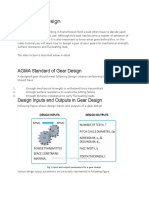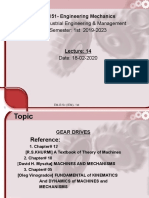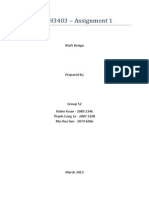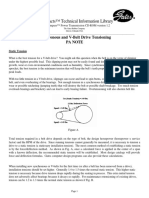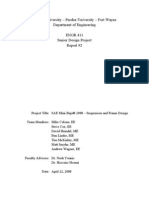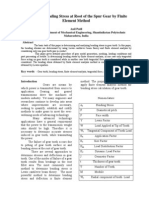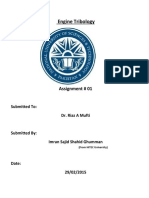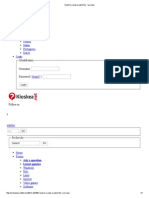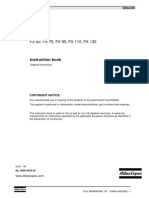Spur Gear Design Learn Engineering
Spur Gear Design Learn Engineering
Uploaded by
Imran Sajid ShahidCopyright:
Available Formats
Spur Gear Design Learn Engineering
Spur Gear Design Learn Engineering
Uploaded by
Imran Sajid ShahidOriginal Title
Copyright
Available Formats
Share this document
Did you find this document useful?
Is this content inappropriate?
Copyright:
Available Formats
Spur Gear Design Learn Engineering
Spur Gear Design Learn Engineering
Uploaded by
Imran Sajid ShahidCopyright:
Available Formats
3/29/2015
SpurGearDesign~LearnEngineering
Home
About us
Contact us
Get your project done
SearchthisSite...
Home
Electrical Engineering
Mechanical Engineering
Civil Engineering
Miscellaneous
About Us
Spur Gear Design
1k
||
Mechanical engineers working in transmission field would often have to decide upon kind of gears they have to use.
Although this task has become a matter of selection of gear based on standards, it is also important to know what goes
behind this. In this video tutorial you will learn how to design a pair of spur gears for mechanical strength, surface
resistance and fluctuating load.
PopularPosts
What is Von Mises Stress ?
Von Mises stress is widely
used by designers to check
whether their design will
withstand a given load
condition. In this lecture we
will un...
How does an Induction
Motor Work ?
Induction motors are the
most commonly used
electrical machines. They are
cheaper, more rugged and easier to
maintain compared to other alte...
Analysis of Beams | Shear
Force & Bending Moment
Diagram
The video lecture is described below in detail
Beams are structural
members, which are most commonly used
in buildings. Beams have numerous other
applications in case of bridges, automobi...
AGMA Standard of Gear Design
How does a Thermal
A designed gear should meet following design criteria conforming to AGMA standards. It should have
Power Plant Work ?
1. Enough mechanical strength to withstand force transmitted
2. Enough surface resistance to overcome pitting failure
3. Enough dynamic resistance to carry fluctuating loads
The purpose of this video
lecture is to give you a
conceptual introduction on
working of thermal power plants. Here
working of a thermal pow...
Design Inputs and Outputs in Gear Design
Principal stress, Principal
Following figure shows design inputs and outputs of a gear design
plane & Mohr's circle
analysis
Concepts of principal stress
and plane form backbone of material stress
analysis. Purpose of this video lecture is to
give you a good introd...
Working of Single Phase
Induction Motors
Single phase induction
motors require just one
power phase for their
operation. They are commonly used in low
power rating applications, in ...
Working of Centrifugal
Pumps
Fig.1 Input and output parameters for a gear design
Various design output parameters are pictorially represented in following figure.
http://www.learnengineering.org/2013/02/spurgeardesign.html
Centrifugal pumps are the
most preferred hydraulic
pumps used in domestic and
industrial world. In this video we will have a
conceptual over...
1/4
3/29/2015
SpurGearDesign~LearnEngineering
Pelton Turbine - Working
& Design Aspects
Pelton turbines/wheels are
suitable for power
extraction, when the water
energy is available at high head and low
flow rate. In this video w...
Working of Refrigerator &
Refrigeration Principle
Refrigeration technology is
commonly used in domestic
and industrial applications
.This article gives a detailed and logical
introduction on...
Working of Steam Turbine
Fig.2 A general spur gear nomenclatures
Steam turbines are heart of
power plant, they are the
devices which transform
thermal energy in fluid to
mechanical energy. In this
Design for space constrains
The designed gear system should fit within a space limit. So the designer could say if he sums pitch diameters of the
mating gears, it should be less than or equal to allowable space limit as shown in figure below.
video le...
RotaryKiln&
Lime
LimeProductionLine
RotaryKiln,Advanced
Structure,FirstChoice.
Fig.3 Space constrain of gear design
The blue rectangle represents space on which gear should get fit. One can take 80% of width of this space as allowable
width for gear design. So following is the relation obtained by this condition.
We also know speed ratio of gears, this will lead to one more relation in terms of pitch circle diameters.
By solving above 2 equations simultaneously we can obtain pitch circle diameters of both the gears.
Determination of Number of Teeth - Interference
Template Hits
1,561,867
Here we will understand how to determine number of teeth on both the gears. To do this we have to assume number of
teeth on one gear(T1), say the smaller gear. Now using the relation given below we can determine number of teeth on
other gear,T2.
So we got number of teeth on both the gears, but one should also check for a phenomenon called interference if gear
system has to have a smooth operation. Interference happens when gear teeth has got profile below base circle. This will
result high noise and material removal problem. This phenomenon is shown in following figure.
Fig.4 A pair of gear teeth under interference
If one has to remove interference , the pinion should have a minimum number of teeth specified by following relation.
Where aw represents addendum of tooth. For 20 degree pressure angle(which is normally taken by designers) aw = 1 m
http://www.learnengineering.org/2013/02/spurgeardesign.html
2/4
3/29/2015
SpurGearDesign~LearnEngineering
and bw = 1.2 m. Module m, and pitch circle diameter Pd are defined as follows.
If this relation does not hold for a given case, then one has to increase number of teeth T1, and redo the calculation. The
algorithm for deciding number of teeth T1 and T2 is shown below.
Fig.5 Flow chart to determine number of teeth on each gears
Design for Mechanical Strength - Lewis Equation
Now the major parameter remaining in gear design is width of the gear teeth, b. This is determined by checking whether
maximum bending stress induced by tangential component of transmitted load, Ft at the root of gear is greater than
allowable stress. As we know power transmitted,P and pitch line velocity V of the gear Ft can be determined using
following relation.
Here we consider gear tooth like a cantilever which is under static equilibrium. Gear forces and detailed geometry of the
tooth is shown in figure below.
Fig.6 Gear tooth under load
One can easily find out maximum value of bending stress induced if all geometrical parameters shown in above figure are
known. But the quantities t and l are not easy to determine, so we use an alternate approach to find out maximum
bending stress value using Lewis approach. Maximum bending stress induced is given by Lewis bending equation as
follows.
Where Y is Lewis form factor, which is a function of pressure angle, number of teeth and addendum and dedendum. Value
of Y is available as in form of table or graph. Using above relation one can determine value of b, by substituting maximum
allowable stress value of material in LHS of equation. But a gear design obtained so will be so unrealistic, because in this
design we are considering gear tooth like a cantilever which is under static equilibrium. But that's not the actual case. In
next session we will incorporate many other parameters which will affect mechanical strength of the gear in order to get
more realistic design.
A More Realistic Approach - AGMA Strength Equation
When a pair of gear rotates we often hear noise from this, this is due to collision happening between gear teeth due to
small clearance in between them. Such collisions will raise load on the gear more than the previously calculated value.
http://www.learnengineering.org/2013/02/spurgeardesign.html
3/4
3/29/2015
SpurGearDesign~LearnEngineering
This effect is incorporated in dynamic loading loading factor, Kv value of which is a function of pitch line velocity.
At root of the gear there could be fatigue failure due to stress concentration effect. Effect of which is incorporated in a
factor called Kf value of which is more than 1.
There will be factors to check for overload (Ko) and load distribution on gear tooth (Km). While incorporating all these
factors Lewis stregth equation will be modified like this
The above equation can also be represented in an alternating form (AGMA Strength equation) like shown below
Where J is
Using above equation we can solve for value of b, so we have obtained all the output parameters required for gear
design. But such a gear does not guarantee a peacefull operation unless it does not a have enough surface resistance.
Design for surface resistance
Usually failure happens in gears due to lack of surface resistance, this is also known as pitting failure. Here when 2 mating
surfaces come in contact under a specified load a contact stress is developed at contact area and surfaces get deformed.
A simple case of contact stress development is depicted below, where 2 cylinders come in contact under a load F.
Fig.7 Surface deformation and development of surface stress due to load applied
For a gear tooth problem one can determine contact stress as function of following parameters
If contact stress developed in a gear interface is more than a critical value(specified by AGMA standard), then pitting
failure occurs. So designer has to make sure that this condition does not arise.
151000T/HStoneCrusher
StoneCrusherforGranite,Basalt,To126+CountryStoneCrusher,Ask!
Newer Post
Home
Older Post
2012-2013 Imajey. The content is copyrighted to LearnEngineering.org & Imajey Consulting Engineers Pvt. Ltd. and may not be reproduced without consent.
Learn Engineering Designed by PSD Style 2011 All Rights Reserved.
http://www.learnengineering.org/2013/02/spurgeardesign.html
Blogger Template by Way2blogging
4/4
You might also like
- How to Rebuild & Modify Ford C4 & C6 Automatic TransmissionsFrom EverandHow to Rebuild & Modify Ford C4 & C6 Automatic TransmissionsRating: 5 out of 5 stars5/5 (5)
- GM Automatic Overdrive Transmission Builder's and Swapper's GuideFrom EverandGM Automatic Overdrive Transmission Builder's and Swapper's GuideRating: 4.5 out of 5 stars4.5/5 (8)
- Scissor Jack Design ProjectDocument27 pagesScissor Jack Design ProjectAbd AlRhman Hashem71% (21)
- Chevy Differentials: How to Rebuild the 10- and 12-BoltFrom EverandChevy Differentials: How to Rebuild the 10- and 12-BoltRating: 5 out of 5 stars5/5 (17)
- Aerodynamics For Engineers (6th Edition) - AbeBooks - Bertin, John J. Cummings, Russell MDocument15 pagesAerodynamics For Engineers (6th Edition) - AbeBooks - Bertin, John J. Cummings, Russell MImran Sajid Shahid0% (4)
- Reverse Your Electric Meter, Legally (Preview)Document18 pagesReverse Your Electric Meter, Legally (Preview)George Wiseman67% (6)
- KissSoft Article GearAnalysisAndOptimization PDFDocument12 pagesKissSoft Article GearAnalysisAndOptimization PDFeng13No ratings yet
- m3277 ProductlistDocument7 pagesm3277 ProductlistSimone100% (1)
- National Oilwell 165T Reciprocating-Plunger-Pumps-Installation-Care-and-Operation-Manual PDFDocument82 pagesNational Oilwell 165T Reciprocating-Plunger-Pumps-Installation-Care-and-Operation-Manual PDFAndres Eduardo100% (2)
- Second Monthly Test Science 10Document4 pagesSecond Monthly Test Science 10Sher Sherwin100% (4)
- Spur Gear DesignDocument6 pagesSpur Gear DesignANILNo ratings yet
- Spur Gear DesignDocument4 pagesSpur Gear DesignKB MambaNo ratings yet
- Ijmet 07 05 023Document12 pagesIjmet 07 05 023SANDEEP BUDANIANo ratings yet
- High Speed Gears-Design and Application by James R. PartridgeDocument10 pagesHigh Speed Gears-Design and Application by James R. PartridgeAbbasAnsariNo ratings yet
- The 2D Tyre Modelling Conundrum and How To Fix It Using Setup ReferencingDocument10 pagesThe 2D Tyre Modelling Conundrum and How To Fix It Using Setup ReferencingbanabanaNo ratings yet
- An Algorithm For Robust Gear Modifications DesignDocument16 pagesAn Algorithm For Robust Gear Modifications DesignAbhijeet DeshmukhNo ratings yet
- SpurDocument57 pagesSpurDangol RupeshNo ratings yet
- Thin Rims For Internal GearsDocument8 pagesThin Rims For Internal GearsMass Giovani100% (1)
- B.Sc. Industrial Engineering & Management Semester: 1st 2019-2023Document62 pagesB.Sc. Industrial Engineering & Management Semester: 1st 2019-2023Hafiz Afaq AliNo ratings yet
- Dynamic Load Analysis and Optimization of A Fracture-Split Connecting RodDocument11 pagesDynamic Load Analysis and Optimization of A Fracture-Split Connecting RodRahul BadgujarNo ratings yet
- Fundamentals of Pulley and WinchesDocument62 pagesFundamentals of Pulley and WinchesvikasgahlyanNo ratings yet
- Design and Fabrication of Toggle JackDocument30 pagesDesign and Fabrication of Toggle JackJitendra Rout0% (1)
- MECH3403 Assignment 1 Report FINALDocument16 pagesMECH3403 Assignment 1 Report FINALCong Thanh LeNo ratings yet
- CH 14Document13 pagesCH 14mssaber77No ratings yet
- Buckling Analysis of Connecting Rod ..Document4 pagesBuckling Analysis of Connecting Rod ..redwan al-mustafaNo ratings yet
- Final MemoDocument9 pagesFinal Memoapi-461820735No ratings yet
- Book - Gears - IndiaDocument12 pagesBook - Gears - IndiadesetekNo ratings yet
- Analysis and Optimization of Connecting Rod (New) Erd-1112-Ces0030Document44 pagesAnalysis and Optimization of Connecting Rod (New) Erd-1112-Ces0030karthikeyanNo ratings yet
- Face Gears: Geometry and Strength: Ulrich Kissling and Stefan BeermannDocument8 pagesFace Gears: Geometry and Strength: Ulrich Kissling and Stefan BeermannosaniamecNo ratings yet
- Simply Supported ShaftDocument18 pagesSimply Supported Shaftjoshswanson7No ratings yet
- Optimization Design of Helical Cylinder Gear ReducerDocument8 pagesOptimization Design of Helical Cylinder Gear ReducerNima FouladinejadNo ratings yet
- Gatesfacts™ Technical Information Library: Synchronous and V-Belt Drive Tensioning Pa NoteDocument2 pagesGatesfacts™ Technical Information Library: Synchronous and V-Belt Drive Tensioning Pa NoteYan's Senora BescoroNo ratings yet
- AGMA Technical PaperDocument14 pagesAGMA Technical PaperLuis TestaNo ratings yet
- Design and Structural Analysis of Spur Gear Using Various MaterialsDocument15 pagesDesign and Structural Analysis of Spur Gear Using Various MaterialsprajeeshNo ratings yet
- Miniature Coupling LOVEJOY PDFDocument12 pagesMiniature Coupling LOVEJOY PDFRafo Vega GuerovichNo ratings yet
- Shaft Design and Flywheel DimensioningDocument13 pagesShaft Design and Flywheel DimensioningihtishamuddNo ratings yet
- Guide To Dyno GraphsDocument10 pagesGuide To Dyno GraphsRajaSekarsajjaNo ratings yet
- Development and Application of A Predesign Tool For Aero Engine Power Gearboxes - ISABE - 2019Document14 pagesDevelopment and Application of A Predesign Tool For Aero Engine Power Gearboxes - ISABE - 2019sarvNo ratings yet
- Design UprightDocument5 pagesDesign UprightJohn HopkinsNo ratings yet
- New Gear Locking Design in Synchromesh Gearbox Which Reduces Gear Shift EffortDocument8 pagesNew Gear Locking Design in Synchromesh Gearbox Which Reduces Gear Shift EffortsamanaveenNo ratings yet
- Ansys Software Question Bank For Baja 2014: SL No. Questions AnswersDocument2 pagesAnsys Software Question Bank For Baja 2014: SL No. Questions AnswerspriyeshdongreNo ratings yet
- Influence of Gear Geometry On Gearbox Noise Reduction - An Experimental InvestigationDocument7 pagesInfluence of Gear Geometry On Gearbox Noise Reduction - An Experimental InvestigationsamanaveenNo ratings yet
- Carjack Minor Engineering ReportDocument27 pagesCarjack Minor Engineering Reportapi-272735514No ratings yet
- Topological Optimization of Steering Knuckle by Using Additive Manufacturing ProcessDocument6 pagesTopological Optimization of Steering Knuckle by Using Additive Manufacturing ProcessdhruvNo ratings yet
- Comparison of Bending Stresses For Different Number of Teeth of Spur Gear Obtained Using MATLAB Simulink With AGMA and ANSYSDocument4 pagesComparison of Bending Stresses For Different Number of Teeth of Spur Gear Obtained Using MATLAB Simulink With AGMA and ANSYSseventhsensegroupNo ratings yet
- Path of Contact CalculationDocument6 pagesPath of Contact Calculationroberto_perraciniNo ratings yet
- Design Analysis of Spur Gear With The Usage of The Advanced ComputerDocument6 pagesDesign Analysis of Spur Gear With The Usage of The Advanced ComputerMohammed JimmyNo ratings yet
- Indiana UniversityDocument64 pagesIndiana Universitymdasifkhan2013No ratings yet
- Manual Transmission ThesisDocument7 pagesManual Transmission Thesisbsdy1xsd100% (2)
- Structural Analysis and Design: STAAD - Pro Concrete Design (FAQ)Document7 pagesStructural Analysis and Design: STAAD - Pro Concrete Design (FAQ)turbobrikNo ratings yet
- Crankshaft Lightweight Design and Evaluation Based On Simulation TechnologyDocument8 pagesCrankshaft Lightweight Design and Evaluation Based On Simulation TechnologyabhinavrmahajanNo ratings yet
- Paper Gearbox enDocument12 pagesPaper Gearbox enVikas TyagiNo ratings yet
- Traction in ElevatorsDocument3 pagesTraction in ElevatorsПавле Крстевски100% (1)
- Mill Spindle Advanced Gear Design: William R. HerbstrittDocument5 pagesMill Spindle Advanced Gear Design: William R. HerbstrittTRUNG QUOC LENo ratings yet
- Motor Tarque CalculationsDocument5 pagesMotor Tarque CalculationsmuhdqasimNo ratings yet
- Bike CrankansysDocument5 pagesBike CrankansysPranav ěýĕѕ ŠpęăқNo ratings yet
- Planetary Gear SystemDocument11 pagesPlanetary Gear SystemNikhil NairNo ratings yet
- Fea AnalysisDocument4 pagesFea Analysisazeem sheikhNo ratings yet
- Design and Optimization of Planetary Gears - DriveConcepts GMBHDocument12 pagesDesign and Optimization of Planetary Gears - DriveConcepts GMBHmayar mimiNo ratings yet
- FFFFFFFFDocument11 pagesFFFFFFFFCan CemreNo ratings yet
- Bolt Torq 0309Document3 pagesBolt Torq 0309jakkakiransNo ratings yet
- Press Fit Pressure Calculator - Optimize Your Interference - Transition Fit DesignDocument2 pagesPress Fit Pressure Calculator - Optimize Your Interference - Transition Fit Designankitsarvaiya100% (1)
- Analysis of Bending Stress at Root of The Spur Gear by Finite Element MethodDocument5 pagesAnalysis of Bending Stress at Root of The Spur Gear by Finite Element MethodAnil PatilNo ratings yet
- Engine Tribology: Assignment # 01Document3 pagesEngine Tribology: Assignment # 01Imran Sajid ShahidNo ratings yet
- HITEC University Taxila, MED Mid Term Paper 2014: DME Lab (5 Semester)Document1 pageHITEC University Taxila, MED Mid Term Paper 2014: DME Lab (5 Semester)Imran Sajid ShahidNo ratings yet
- Wiley - Low-Speed Wind Tunnel Testing, 3rd Edition - Jewel B. Barlow, William HDocument2 pagesWiley - Low-Speed Wind Tunnel Testing, 3rd Edition - Jewel B. Barlow, William HImran Sajid Shahid0% (1)
- WEDDocument7 pagesWEDImran Sajid ShahidNo ratings yet
- Aerodynamic DragDocument2 pagesAerodynamic DragImran Sajid ShahidNo ratings yet
- Congratulations, You Have Been Awarded An Extra 1 Reputation Points. Thanks For Being Human and Not A Spambot. 12 Karma Is The Dividing LineDocument4 pagesCongratulations, You Have Been Awarded An Extra 1 Reputation Points. Thanks For Being Human and Not A Spambot. 12 Karma Is The Dividing LineImran Sajid ShahidNo ratings yet
- Identification Username PasswordDocument7 pagesIdentification Username PasswordImran Sajid ShahidNo ratings yet
- XZXDocument2 pagesXZXImran Sajid ShahidNo ratings yet
- P P P Piiii W W W W: Numerical Methods For Elliptic EquationsDocument52 pagesP P P Piiii W W W W: Numerical Methods For Elliptic EquationsImran Sajid ShahidNo ratings yet
- Rank Mismatch in Argument (Fortran 90)Document3 pagesRank Mismatch in Argument (Fortran 90)Imran Sajid ShahidNo ratings yet
- Free SurfaceDocument2 pagesFree SurfaceImran Sajid ShahidNo ratings yet
- Thixotrophic Materials With FLOW Cast 3.1.1: 2009-02-06 Tuomas Tynjälä Simtech Systems IncDocument4 pagesThixotrophic Materials With FLOW Cast 3.1.1: 2009-02-06 Tuomas Tynjälä Simtech Systems IncImran Sajid ShahidNo ratings yet
- Wavelet Based Signal Demodulation Technique For Bearing Fault DetectionDocument10 pagesWavelet Based Signal Demodulation Technique For Bearing Fault DetectionImran Sajid ShahidNo ratings yet
- TFMOV 20S - SETsafe & SETfuseDocument18 pagesTFMOV 20S - SETsafe & SETfusesandeepphedelenterprisesNo ratings yet
- Sohail Villa - Ahu Technical ReportDocument30 pagesSohail Villa - Ahu Technical ReportAslamNo ratings yet
- Journal of Food Quality - 2022 - Kumar - Retracted Design and Fabrication of Solar Dryer System For Food Preservation ofDocument15 pagesJournal of Food Quality - 2022 - Kumar - Retracted Design and Fabrication of Solar Dryer System For Food Preservation ofSeptina KasehNo ratings yet
- PACCAR Engine Manuals - PACCAR MX Engine Operator's ManualDocument100 pagesPACCAR Engine Manuals - PACCAR MX Engine Operator's Manualbruno_borges90No ratings yet
- Gas Interference Sucker Rod PumpsDocument9 pagesGas Interference Sucker Rod PumpspohanisirNo ratings yet
- EngineDocument208 pagesEngineIstván Kiss100% (1)
- 2.1 Energetics TestDocument8 pages2.1 Energetics TestLiew ExuanNo ratings yet
- ERITECH Grounding & Bonding Catalogue PDFDocument68 pagesERITECH Grounding & Bonding Catalogue PDFanji201No ratings yet
- Tmov and I TMOV Varistor SeriesDocument9 pagesTmov and I TMOV Varistor SeriesAdityaJayakarNo ratings yet
- Pag. 151 (Pentru Anul 1999)Document274 pagesPag. 151 (Pentru Anul 1999)Cosmescu VictorNo ratings yet
- Contenidos Sintáctico-Discursivos - Conocimientos de SintaxisDocument14 pagesContenidos Sintáctico-Discursivos - Conocimientos de SintaxisBeatriz AlvarezNo ratings yet
- Ductile Brittle Transition Temp For SA-53 & SA-106Document29 pagesDuctile Brittle Transition Temp For SA-53 & SA-106minhphuongphamNo ratings yet
- Analysis GravimetriDocument11 pagesAnalysis GravimetriRinda As EtaNo ratings yet
- Mcqs of WorkDocument5 pagesMcqs of WorkIjaz TalibNo ratings yet
- Polymet Full Product CatalogueDocument2 pagesPolymet Full Product Catalogue.xNo ratings yet
- NTC 2008 Key ChallengesDocument6 pagesNTC 2008 Key ChallengesKasımNo ratings yet
- MeganeCoupeAndRenaultsport PDFDocument20 pagesMeganeCoupeAndRenaultsport PDFCaroline PuckettNo ratings yet
- Man FX60 A FX130 9828093385 Ed 00 (EN)Document18 pagesMan FX60 A FX130 9828093385 Ed 00 (EN)Jarvis Millare100% (1)
- StockDocument38 pagesStockdalemanukNo ratings yet
- QB 1-U19MC402 - Thermodynamics and Heat TransferDocument2 pagesQB 1-U19MC402 - Thermodynamics and Heat TransferDineesh babu LNo ratings yet
- Complete ReportDocument16 pagesComplete Reporterhamfatima3No ratings yet
- 11th Chemistry Important Questions With AnswersDocument18 pages11th Chemistry Important Questions With Answerswowgamer349No ratings yet
- ARDES-IMRAD-FORMAT daNEDocument13 pagesARDES-IMRAD-FORMAT daNEdaniellemacayanbNo ratings yet
- 4.basf - 855 - e 17 (TC) - Ima Spain - Up ScalinDocument27 pages4.basf - 855 - e 17 (TC) - Ima Spain - Up ScalinPaqui Miranda GualdaNo ratings yet
- Wolkem India 300 HP Motor Against RGP 323002412239Document2 pagesWolkem India 300 HP Motor Against RGP 323002412239chinky88712No ratings yet
- Project ReportDocument30 pagesProject ReportShyam Kumar RastogiNo ratings yet











